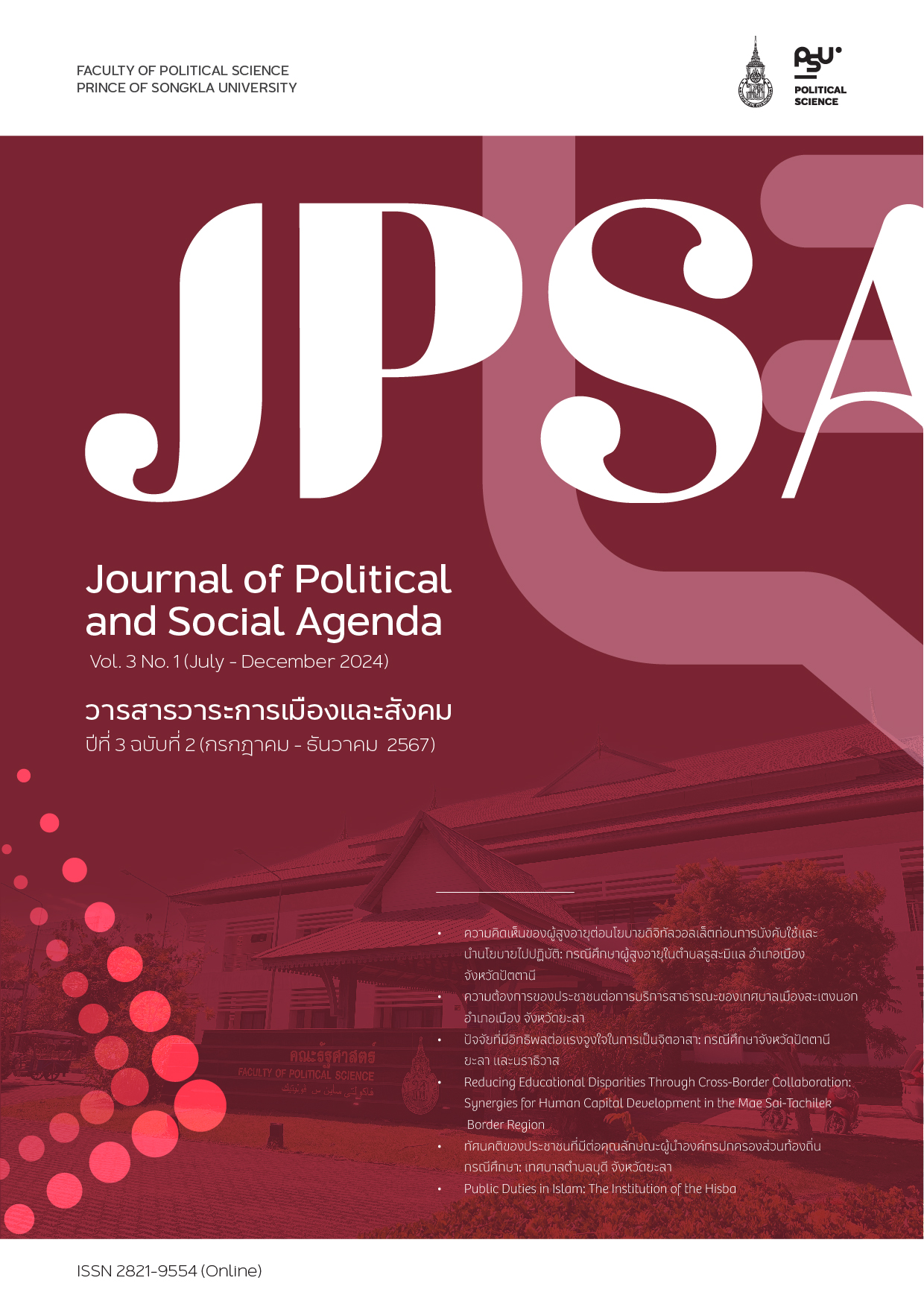Reducing Educational Disparities Through Cross-Border Collaboration: Synergies for Human Capital Development in the Mae Sai-Tachilek Border Region
Main Article Content
บทคัดย่อ
Educational inequality, especially between urban and rural areas, remains a global challenge, with border regions facing unique socio-political and economic barriers. The Mae Sai-Tachileik border, dividing Myanmar and Thailand, exemplifies these challenges due to political instability, economic underdevelopment, and cultural diversity. This study investigates: How can cross-border educational collaboration improve access to education and reduce disparities in the region? By applying Sen’s Capability Approach (expanding individual freedoms through education) and Ostrom’s Collective Approach (stakeholder collaboration), the research examines initiatives like bilingual education, joint vocational training, and cross-cultural exchanges. These efforts have led to a 15% increase in school retention rates in targeted communities (World Bank, 2022), along with improved vocational skills and language proficiency, enhancing employability. Programs also fostered cultural understanding and cooperation, strengthening socio-economic ties. The research highlights human capital development as a key outcome, showing how educational synergy equips individuals with skills to improve socio-economic prospects. Employing a research-based approach through literature review and document analysis, including stakeholders like local communities, governments, NGOs, and the private sector, this study explores how these entities enhance educational access and quality. While acknowledging limitations such as potential data biases, the study addresses challenges rooted in political instability, economic disparity, and cultural diversity. Ultimately, it proposes a combined framework to reduce disparities, foster sustainable development, and strengthen socio-economic connections, with human capital development identified as a core driver.
Article Details

อนุญาตภายใต้เงื่อนไข Creative Commons Attribution-NonCommercial-NoDerivatives 4.0 International License.
บทความที่ได้รับการตีพิมพ์ในวารสารออนไลน์เล่มนี้เป็นลิขสิทธิ์ของวารสารวาระการเมืองและสังคม ความคิดเห็นและข้อถกเถียงที่ปรากฏในบทความเป็นความรับผิดชอบของผู้เขียน บรรณาธิการวารสารฯ ไม่มีความเกี่ยวข้องใด ๆ กับความคิดเห็นของผู้เขียนและไม่จำเป็นต้องเห็นด้วยกับความคิดเห็นของผู้เขียน
เอกสารอ้างอิง
Anderson, J., & Black, S. (2020). Education in border regions: Addressing socio-political barriers to equity. Journal of Borderland Studies, 35(2), 189–204.
Anderson, J., & O’Dowd, L. (2019). Borders, nationalism, and identity in a globalizing world. Journal of Borderlands Studies, 34(1), 1–18.
ASEAN. (2012). ASEAN human rights declaration. Association of Southeast Asian Nations.
Creswell, J. W., & Poth, C. N. (2018). Qualitative inquiry and research design: Choosing among five approaches (4th ed.). Sage Publications.
Harris, A., & Jones, M. (2020). Educational inequalities and their impact on human development. Springer.
Human Rights Watch. (2021). The impact of conflict on education in Myanmar. https://www.hrw.org/ [DOI: 10.1073/hrw.2021.world02]
Hurtado, M. (2020). Cultural diversity and education in border regions. Comparative Education Review, 64(4), 561–583.
Jones, A. (2019). Comparative analysis of educational programs. Journal of Education and Development.
Lee, M. (2021). Stakeholder engagement in educational initiatives. Education and Policy Journal.
Miller, R. (2022). Advocacy in education policy: Effective strategies. Policy Studies Journal.
OECD. (2020). Education at a glance 2020: OECD indicators. OECD Publishing. https://doi.org/10.1787/f8d7880d-en
OECD. (2021). The state of education: Bridging the urban-rural divide. Organization for Economic Co-operation and Development.
Ostrom, E. (1990). Governing the commons: The evolution of institutions for collective action. Cambridge University Press; 1990. https://doi.org/10.1017/CBO9780511807763
Patel, S. (2023). Technology integration in education. Journal of Educational Technology.
Patton, M. Q. (2015). Qualitative research & evaluation methods: Integrating theory and practice (4th ed.). Sage Publications.
Sen, A. (1999). Development as freedom. Oxford University Press. https://iep.utm.edu/sen-cap/
Smith, J. (2020). Longitudinal studies in educational research. Research in Education.
Todaro, M. P., & Smith, S. C. (2020). Economic development (13th ed.). Pearson.
UNDP. (2019). Human development report: Beyond income, beyond averages, beyond today: Inequalities in human development in the 21st century. United Nations Development Programme. https://hdr.undp.org/en/2019-report
UNESCO. (2015). Education for all 2000-2015: Achievements and challenges. United Nations Educational, Scientific and Cultural Organization. https://unesdoc.unesco.org/ark:/48223/pf0000232205
UNESCO. (2019). Right to education handbook. United Nations Educational, Scientific and Cultural Organization.
UNESCO. (2020). Global education monitoring report 2020: Inclusion and education: All means all. UNESCO Publishing.
UNESCO. (2021). Educational challenges in border regions. UNESCO Institute for Statistics.
UNESCO. (2021). Education in rural and remote areas: Challenges and strategies. UNESCO Institute for Lifelong Learning. https://unesdoc.unesco.org/ark:/48223/pf0000370861
UNICEF. (2020). Educational disparities in border regions. United Nations Children’s Fund.
UNICEF. (2020). The state of the world's children 2020: Children in a digital world. UNICEF Publishing.
UNICEF. (2023). The state of education in Myanmar: A report on educational inequities. United Nations Children's Fund.
United Nations. (1948). Universal declaration of human rights. United Nations.
United Nations. (1989). Convention on the rights of the child. United Nations. https://www.ohchr.org/en/instruments-mechanisms/instruments/convention-rights-child
United Nations. (2015). Transforming our world: The 2030 agenda for sustainable development. United Nations.
World Bank. (2021). Education in border regions: Lessons from cross-border collaborations. World Bank.
World Bank. (2022). Borderland education: Policy frameworks and implementation challenges. World Bank Group.
World Bank. (2022). Education for resilience: Strategies for reducing disparities in border regions. World Bank Publications.
World Bank. (2022). The economic impact of education on development. World Bank Publications.


